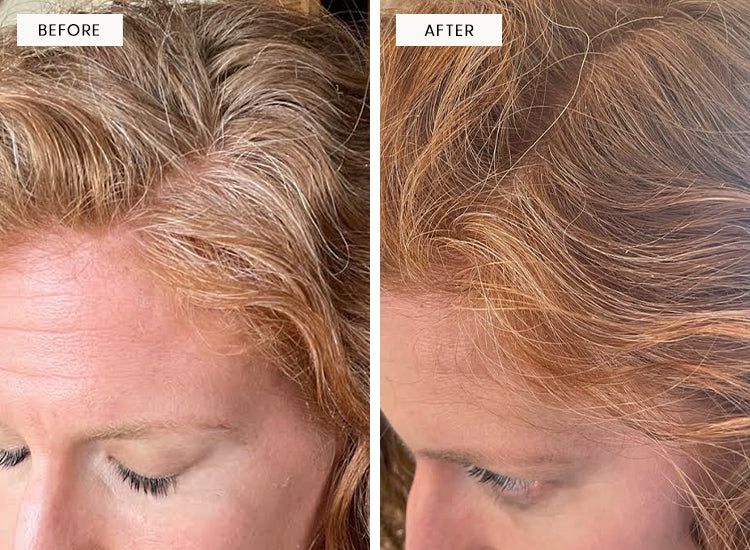Contents
We took a deep dive.

Regardless if you’re a self-proclaimed beauty fanatic or not, most of us can remember the first time we spotted a rogue strand of gray hair — a gasp of recognition as you looked in the mirror, the wiry sprout peeking out from your scalp like a unwelcome party guest.
Even if your most recent birthday has yet to send your anxiety levels through the roof, those initial gray hairs can feel like a particularly harsh reminder that yes, we are all getting older. Simply put, becoming a silver fox is inevitable for most people, whether your first gray hair appears in your 50s, 40s, or before you even graduated college (the decision to allow your natural color to shine through is a dilemma for another day). But is going gray the inescapable rite of passage we always believed it to be? According to some hair experts, maybe not.
In the race to delay those inevitable grays, many hair-care brands are debuting products that promise to not only prolong your natural color but also repigment silver strands that have already appeared. Such claims almost sound too good to be true, especially in today’s youth-obsessed culture, which is why any beauty formulator had better come to market with the receipts to back them up.
Keep reading to learn whether or not it’s possible to reverse going gray or if it’s all just wishful thinking.
Why Does Hair Turn Gray?

Although modern science has significantly prolonged the human lifespan over the last two centuries there are some side effects of aging that continue to thrive despite our best efforts, gray hair among them. However, for all the time spent optimizing our bodies to the best of our ability, the exact mechanism by which hair turns gray is still not completely understood. As board-certified dermatologist and Hims and Hers medical advisory board member Sara Perkins, MD, explains, “There are many factors at play [with graying hair], including genetic, environmental, metabolic, and nutritional.”
She adds that ultimately the body’s pigment-producing cells, called melanocytes, stop producing melanin — the pigment that gives skin, hair, and eyes their color — which leads to gray and then white hair. That means that your hair doesn’t exactly turn a shade of gray so much as the color in the strands fades until the pigment is no longer present.
When Will You Start to Go Gray?
The age at which you’ll start seeing grays varies widely across age, ethnicity, gender, and even lifestyle. Some people might experience Premature Graying of Hair (aka PGH), which, for example, is before the age of 20 for Caucasians and before 30 for the Black population, but the average age demographic for these groups to start going gray is in the 30s and 40s respectively. Like most “anti-aging” choices in the beauty space, lifestyle can also contribute to the age at which your hair will turn gray.
Both emotional stress, the kind that raises your body’s cortisol levels, and oxidative stress, when the body’s antioxidant levels are low, courtesy of free-radical damage, can kick off the graying process. As Idris Rubin, MD, board-certified dermatologist and founder of SEEN Skin and Hair, explains, “Stress can lead to gray hair by affecting the stem cells that create pigment-producing cells called melanocytes. This study found that the chemical norepinephrine, produced when the body experiences stress, can convert stem cells to pigment cells that then move out of the follicle.” She adds that oxidative stress from internal or external free-radical damage can also affect the production of pigment within the hair follicles. So whether it’s a stressful life event or you moved somewhere with high levels of pollution, your likelihood of sprouting more grays is going to increase.
Gray Hair Prevention
Prevention is a much more effective strategy when dealing with gray hairs, as opposed to reversing them altogether. “A healthy diet and lifestyle, along with stress management, can keep your hair color and you as healthy as possible,” says Dr. Perkins. Modifying your lifestyle is one of the few factors you can control over the graying process (as opposed to aging and genetics), so if you want to hold off the age at which you’ll see silver strands, it’s wise to pay careful attention to your environmental exposures, diet, and stress levels.
Utilizing products that contain antioxidant ingredients to fight free-radical damage is also a promising step toward preventing more gray hairs, especially when your hair still has plenty of natural color. It can also improve your hair's condition and density, both of which decline with age. Again, addressing gray hair is not as simple as one clear solution to prevent loss of pigment, which is why many hair care brands are exploring advanced formulas as more research emerges (more on that in a minute).
Is It Possible To Reverse Gray Hair Growth?

If gray hairs have you disheartened (especially if you’ve yet to hit 40), you might be in luck. As recently as last year, studies have found that, yes, we can theoretically reverse going gray, but there is a caveat for who is eligible.
A 2021 study from Columbia University discovered that some participants saw a reversal of graying when emotional stress decreased, but this is still a fairly uncommon occurrence. In order to stimulate melanin synthesis and, therefore, reverse gray hair, whether through topical agents, photodynamic therapy, or microneedling, a person needs to have enough melanocyte stem cells, which produce the pigment cells for our hair. Although more research is required, it is widely accepted that without these stem cells (which cease to function with age), no amount of treatment will restore hair’s original color, nor is there any effective treatment to repigment hair at this stage. Only time will tell if science can find a way to reactivate those cells and maintain melanin production, but public interest is certainly there for research to move forward.
Since there are numerous factors at work as hair turns gray, many hair care brands are eagerly developing products to keep your hair pigmented for as long as possible. One of the newest to hit the gray prevention market is the Living Proof Scalp Care Density Serum, which boasts an antioxidant-rich Anti-Grey Complex.
“Our Anti-Grey Complex combats graying through a blend of amino acids and potent antioxidants to help protect pigmentation against oxidative stress and maintain your natural color,” says Ron McLaughlin, senior VP of research and development at Living Proof. He notes that the team conducted independent clinical trials for the product, recruiting participants with 25 percent gray hair at a minimum (and self-assessed thinning hair). After the 90-day trial period, 76 percent of participants experienced a decrease in new gray hair growth (using individual fiber counts) compared to baseline in a 12-week study of 30 participants using the serum once daily.
In addition to topical products like the Vegamour GRO AGELESS Anti-Gray Hair Serum and Phyto Paris RE30 Anti-Grey Hair Treatment (both of which have middling to positive reviews), supplements remain a popular option for hair care brands seeking to delay the graying process, such as the Arey Not Today, Grey. “This is a proactive product and works best in the early stages of graying [for consumers with] less than 30 percent gray hair [to retain their color],” says Jay Small, hairstylist and Arey co-founder of the supplement. “The ingestible formula contains ingredients like vitamin D, copper, B12, and fo-ti that are purported to prevent premature graying, fuel melanin production, and improve the protective protein structure of the hair.
Arey also offers a topical treatment called To The Root, which utilizes a peptide and patent-pending blend of antioxidants to slow and re-pigment gray hair. While consumer testimonials are relatively positive, co-founder Allison Conrad explains that the brand is currently conducting clinical tests on the products and has yet to release the results. Still, for anyone looking to minimize oxidative stress — which can impact not only the rate at which your hair loses pigment but also the condition of your skin — supplementing your hair care regimen with strengthening vitamins and minerals isn’t going to make your grays any worse.
So, while we’ll likely remain in the era of unavoidable gray hairs for the time being, all evidence suggests that the research and product development are heading in an innovative direction. For now, we suggest stocking up on plenty of purple shampoo to keep those existing grays vibrant and silvery — or chatting with your colorist about a steady stream of touch-up appointments. Whatever path feels right for you, there’s no wrong approach when it comes to going gray gracefully.

